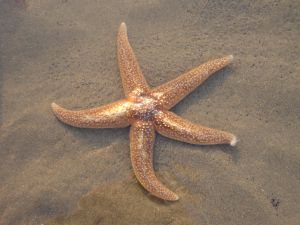Sea Stars

Sea stars from the class Asteroidea can be found in all the oceans, but you will find the richest variety of species in the northern Pacific Ocean. Ophiuroidea sea stars are also found in marine environments all over the world, and are famous for their capacity to survive at great depths. Sea floors located further down than 500 metres are often filled with this type of sea star and Ophiuroidea sea stars occur as deep as > 6000 m. They can however also be found in much more shallow waters and inhabit coral reefs. A few of the Ophiuroidea can survive in brackish conditions; a rare capacity among members of the phylum Echinodermata.
A sea star is typically equipped with at lest five “arms” which radiates out from a disc-shaped main body. A five arm construction creates a form of symmetry known as pentaradial symmetry, where the arms are arranged 72° apart. Even though most sea stars have five arms, some species have less than five arms, while others have more than five arms. The amount of arms can even vary within one species. The sea star has no movable skeleton and will instead use a hydraulic water vascular system. You will find the mouth of your sea star under its body and the anus on top.
Keeping a Ophiothrix sp. sea star
Ophiothrix sp. is one example of a Brittle star that is commonly found in reef aquariums where it works as a scavenger and helps keeping the reef clean. This sea star consists of a small olive green disc with long spiny arms. The patterns on the disc can vary from specimen to specimen, and the arms are yellow with black or white spines.The Ophiothrix sp. is considered moderately hard to keep and it is very sensitive to rapid environmental fluctuations. You must keep the levels of salinity, oxygen and pH very stable in an aquarium where you house this sea star. If you choose to keep a Ophiothrix sp. you will not be able to use copper-based remedies to medicate your aquarium, since this sea star can die even from low concentrations of copper. Be careful when you transport your sea star and never allow it to become exposed to air. Most specimens offered in fish stores are 3-6 inches, but they can eventually reach a size of 10 inches. It is a semi-aggressive species.
The Ophiothrix sp. originates from the Caribbean and will do best when the water temperature is kept between 72 and 78° Fahrenheit. The sg. should be in the 1.023-1.025 range, the pH 8.1-8.4, and the dKH from 8 to 12.
Ophiothrix sp. is a nocturnal sea star that will prefer to stay hidden under rocks as long as the light is on. During the night, it will feed on detritus and other small organisms. You can feed your sea star meaty foods if you chop the pieces very finely. Liquid invertebrate food and zooplankton are also appreciated.
Sea star Articles
Sea star facts - Intersting and fun acts about sea stars such as the fact that they are in no way related to fish.
